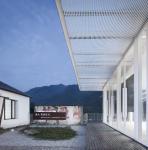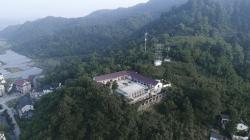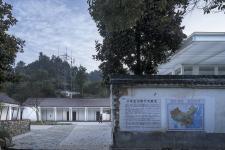Source of Project
“Qingyuan Young Professors’ Club” derives from the former site of Qingyuan Primary School in Qingyuan Village, Tonglu County, Hangzhou. It includes two reconstructed old school buildings and a new building which can contain one hundred people. The site of the project will be “Young Professors’ Scientific and Technological Creativity Base of Zhejiang University” for promoting the industry-study-research cooperation between Qingyuan Village and Zhejiang University.
Site investigation
Looking up at the hill, there is an indistinct house at hillside. You may not think it was once a primary school. Two single-floor old school houses arrange simply in shape “L”; the other two sides are walls.
There is a platform in moderate size out of the walls. Continuous green hill encloses the school. Although it is old and shabby, it has historical and humanistic features and the features of natural scenery.
The wooden framework and some purlins of school building have been in disrepair; most roof battens, plank sheathings and tiles become shabby.
There is a water tower with story out of the south wall. “Qingyuan Pool” can be dimly seen on the tower. It is said that it once supplied water to the whole village. Since tap water could be available, the water tower has been abandoned…
Start of design
The encounter with history is like the encounter with confidant. It may be the best attitude to understand it, respect it, not agitate it and mutually maintain proper gap.
As for the roof of the old school building, we decide to reconstruct it in the principle “repair and maintain the old”. Walls and pillars can be properly added. It is suggested to dismantle old and relatively shabby tiles, roof battens and plank sheathings, retain, burnish, process and reinforce large wood beams and purlins, install new plank sheathings, roof battens and tiles and make it take on an altogether new aspect without losing memory.
Before the design, the team has sufficiently investigated the base. A college-graduate village official accompanying the site investigation once asked: “can memories be left in the new base when the school is reconstructed? ”
There are two stone walls which are bare because of the loss of lime plaster indoors. They have exquisite color and interesting texture. It can be a superexcellent background. Through repair, we have reconstructed the room to be a small audio and visual room.
As for side corridor, based on the shabby purlins and the loss of sense of order, it is decided to use new wooden framework + customized knitted summer mat (scroll can be used to manually control the length of the mat). In this way, the external façade of the original corridor (toward inner yard) forms new building language. The sense of order of new pillars and specific gray space feeling endow new expression to the old building in inner yard without losing the original style and memory.
Besides the repair to old site of the base, we also need to build a new house which can contain about one hundred people for holding small summit or forum. We choose the southeast part of the base, from which we can look far into the villages at foot of the hill and the distant mountains. The structural size of the new house is 8.8m×16m×4.5m (height). In order to make building hide in eastern scene in liberated and completely open posture as far as possible, completely open glass doors in uniform size (2.4m×4.2m) are used for façade.
Our vision shall not be shielded and the structure shall be autonomic and relaxing. Size of the glass doors of the new building is very close to that of the pillars of the two reconstructed old houses. If you watch the new and old building in inner yard, they are different but become an unified entity with the background of mountains.
In the east of the new house, there is an outdoor platform which is lower than the house. A stone enclosure surrounds it. A row of one-storey houses may exist but their roof is lost. There are many holes on stone walls. Although the holes are not complete, the remote scenery can be felt. We use rectangular modern rusty boards to add a row of frameworks of scenery. When you view from the inside to the outside, you can feel strong sense of integration and design from the natural, modern and historical substances.
We have paved a layer of simple outdoor floor on the deserted platform inside and added a white modern steel ladder beside wall. This completes the functional connection with the newly-built glass box.
Looking from eastern foot of the hill or remote place, a newly-built clean glass box is placed on stone wall with immemorial memory. Branches of trees flicker; glass doors are open or closed. A new picture is presented. Beside the south side of inner yard—the entrance of the original primary school, the western half of enclosure has been dismantled; the eastern ceramic tile mark with time trace has been reserved. In this way, the mottled water tower will be thoroughly presented and become an indispensable scenery element in inner yard. To thoroughly open the inner yard and continue to integrate it into environment, add an outdoor corridor built on stilts in the west of the water tower from the inner yard. People can keep off thistles and thorns, bypass southwest side of the site and go to the west of the old school building. Then people can look far into the distance. There is an orchard on the hillside.
Conclusion
Under the new wooden framework, in the dim and transparent glass box, under eave and on the platform, you can see the mottled walls with memory and the words with story and look far into the mountains and the sun… Memory appears; scene appears; and then poetry appears.
It is our attitude to strictly treat the relationship with history and dimly settle a new house without rigor, flaunt or showing off technique. We hope it is tranquil and harmonious between the old and the new, the external and the internal, the upper and the lower, and the remote and the near.
2015
2017
Building area (square meter or square foot): 620.11 square meters
Address of the project: Qingyuan Village, Jiangnan Town, Tonglu County, Hangzhou City, Zhejiang Province, China
Architects in Charge: Hu Huifeng, Peng Rongbin, Jiang Lanlan
Design Team: Li Congxiao, Jia Zhongdi, Wang Lulu, Lv Ning, Deng Yue, Li Zheye, Yu Le, Lv Xiaofeng, Chen Xian
Structure Engineer:Jin Jugao, Kan Jianzhong
Water Supply and Drainage Engineer: Zhou Xin
Electrical Engineer: Yang Kai, Yang Wenzheng
Heating and Ventilating Engineer: Diao Yuefeng, Sun Biao
Construction company: The Architectural Design and Research Institute of Zhejiang University Co., Ltd.
Website of the Company: http://www.zuadr.com/
E-mail: [email protected]
Client: the government of Jiangnan Town, Tonglu County, Hangzhou City, Zhejiang Province, China























